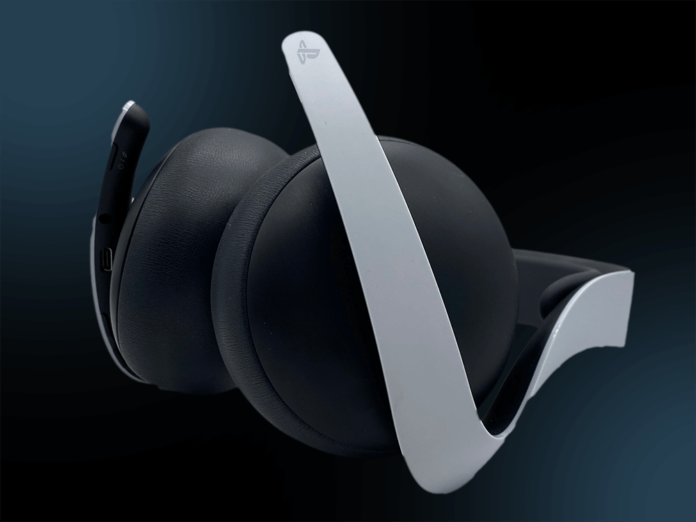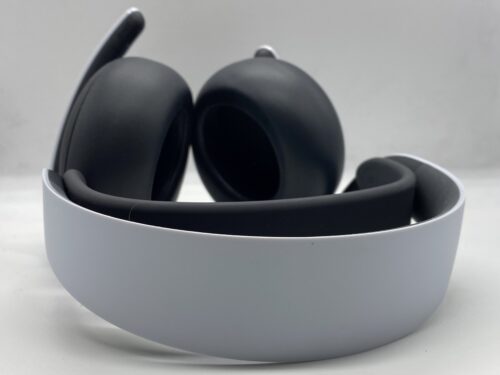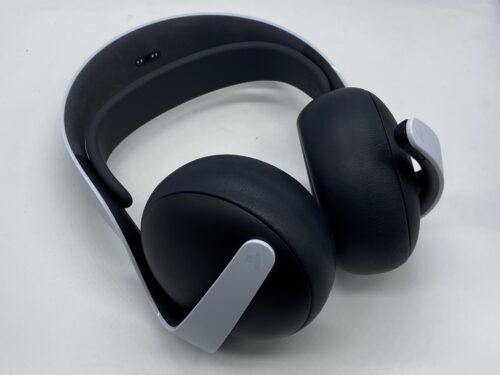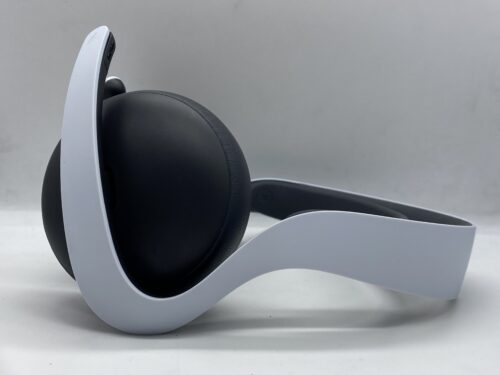Since Sony acquired Audeze, they’ve been focusing on updating their Pulse gaming line with new planar drivers. A few months ago, I reviewed Sony’s Pulse Explore true wireless gaming earbuds, which were the first to adapt this new configuration. Now, Sony has updated their Pulse over-ear gaming headphones with the new Pulse Elite. They’re only fifty dollars more than what the Pulse 3D goes for now, which might give you more incentive to go straight for the Elite if you’re interested in a pair of gaming headphones for your PS5. Is the change compelling enough though?
What You Get
- PULSE Elite™ wireless headset
- PlayStation Link™ USB adapter
- PULSE Elite™ charging hanger
- Mounting plate*
- USB cable
- Printed materials
Look & Feel
There’s been a lot of talk about what’s changed on the inside of the Elite, but the outside has its fair share of upgrades too. Everything about its frame still tries to resemble the shell of the PS5, with its yokes cutting across the earcups this time around. This works as a cool aesthetic difference, and also a way to better access the on-board microphone. It also makes the button controls feel natural to use, and I found myself using them a lot. It’s a strange design for a headphone, but the Elite uses its unique features to be more practical.
Wearing the Elite for a few hours never wares on you, as the ear pads secure your ears comfortably, while the suspension headband relieves some of the pressure on your head. It’s a light fit that I had no issue with, aside from the fact that I found myself readjusting their position on my head a few times.
Design & Functionality
One of the most advertised features of the Pulse Elite is its new planar driver. It was implemented well with the Explore, but more refined here as expanded on in the sound analysis section of this review. Otherwise, the main features of the Pulse Elite will be found when paired with the PS5. You have your standard volume control, but the main power button is multi-functional. You use it to link the headphones to your PlayStation, but if you press it three times it brings up your sound settings. I used EQ controls with the Elite regularly, so having this action came in handy.
Microphone Quality
Like the Pulse Explore, the Elite uses Sony’s AI-enhanced noise rejection when you’re using voice chat. Unfortunately, also like the Pulse Explore the Elite has issues when it comes to mic quality. For the Elite, hearing outside noise is no issue. The real problem is how others hear you through it. When chatting with my friends through PS5 and Discord, the sound of the mic came across as boxy. Others even claimed the mic had a crunch to it that made my voice a bit unclear at times.
Bluetooth
When I reviewed the Pulse Explore, I liked the fact that you can use it with PlayStation Link and Bluetooth at the same time. The Elite has the same multipoint functionality, which I used quite a bit throughout my testing. It should be noted that Bluetooth can only work with the Pulse Elite when it’s connected to the PlayStation Link first. When connected through Bluetooth, you also don’t get access to low latency and lossless audio.
Battery Life
With a full charge of the battery, you should be able to enjoy the Pulse Elite for up to 30 hours. It has fast charging too, with only 10 minutes of charge time translating to 2 hours of use. Thanks to the included charging hanger, there are two ways to charge the headset.
Soundstage
Most of my time with the Pulse Elite I was using 3D audio through the PS5. I had a short time listening to Apple Music through the PS5 in standard stereo, and it was not unlike what other Sony wireless headphones can handle, at least in terms of accuracy and spaciousness. I get the same impression of the width and imaging here as I do with the 1000x series. Musicality can vary, but the planar drivers do make the sound feel more breathable and organized. Everything is more coherently stacked instead of fighting for the middle with forward bass.
Using 3D audio with games is what the Pulse Elite is designed for, and brings out the best characteristics of the soundstage and imaging. If you’re listening to the Pulse Elite in standard stereo with most games, you’ll be missing out on getting the most immersion out of your games. How well does the Pulse Elite perform with 3D audio though? In most cases, the positioning of sound elements was not exact but stood out more in front of you. Ambiances wrap around you and encase your head in a dome, while other effects aim for specific directions past the right and left channels. I didn’t find the Pulse Elite very wide, but the headspace it presents through spatial audio makes soundscapes still come across without boundaries.
I became very impressed by the Elite’s spatial capabilities while playing Silent Hill: The Short Message. Upon starting the game I began to notice the very realistic outside wind sounds. These sounds were surprisingly direct through the Elite and effectively highlighted the game’s atmospheric sound design. Playing this game also showcased the positioning of specific effects as well. Certain sequences have you running away from a monster, and the Pulse Elite did a great job communicating where exactly the monster was coming from, and it helped me make decisions on where to go.
Low End
I usually find Sony’s headphones, gaming or not, to be very bass-heavy. Sometimes this works for and against its sound signature, as the lows tend to cause some fogginess. With the Pulse Elite, the bass has a tighter performance, like the sound signature has more of a grip on its frequency response. Everything feels a bit more stationary and less loose.
You still get a very weighty response that supplies shape and texture to the bass, but the Elite provides a lot more balance than other Sony gaming headphones. I actually felt compelled to boost the bass using the PS5’s EQ. Their bass boost preset came in handy while playing Silent Hill: The Short Message, as it helped elevate the general room tone. The Elite was able to bring out the presence, adding a layer of intended discomfort.
Mids
While I was able to adjust the bass in a way that complimented the games I was playing, doing the same for the mids showed me a bit of frustration. No matter what I just couldn’t get the mids to sit in a place where they felt even. I kept trying to boost the mids to not feel as empty, but to no avail. The planar driver helps widen the range of details that can be heard, but their timbre still lacks complete transparency. Only in some games is the hollowness of the mids distracting. While playing Elden Ring, the Pulse Elite was able to capture the weight and scale of the music and sound design, but tonally, some of the sounds were a bit empty.
Everything is given its space though, as the Pulse Elite can properly communicate music and sound design with relative ease and organization. Nothing is relegated to the background too much, which is very impressive for a set of gaming headphones in this price range. During boss fights in Elden Ring, the Elite can portray both the bombastic music and the impactful sound design of the boss and your attacks in a way that appears more punctual. There’s an accentuated upper midrange that gives effects like sword slashes an extra sheen of texture. This also affects other sounds like the crunch of grass underneath your feet, as well as Torrent’s.
Highs
I found the highs on the Elite to be surprisingly expressive, and not afraid to show a bit of brightness. It never feels like the Elite is holding back anything with its highs even without EQ. That emphasized texture from the upper-mids expands into a glisten that accentuates the tail of certain sounds. Parrying attacks in Ghosts of Tsushima has a crisp ring to it through the Elite, showcasing its ability to provide sparkle and definition throughout its sound signature. The treble expands the height of the response quite a bit, giving these fine details plenty of room to take shape. These frequencies can get pretty aggressive at some points too, but it’s always brought under control to not become too peaky or distorted.
Summary
There’s a bright future for more premium gaming headphones from Sony, and it starts with the Pulse Elite. Its implementation of planar drivers grants more opportunities for the sound to flourish, even if parts of the sound signature still stumble a bit. It’s only just short of sounding premium and audiophile though. Most games sound fantastic with the Elite anyway, with spatial audio playing an integral role in its immersion. The Elite responds great with it, mimicking all the right aspects about the dome like imaging of formats like DTS and Dolby Atmos. What Sony needs to work on the most is its microphone quality. While the AI noise rejection technology works, the actual timbre of the microphone still has some problems. If voice chat isn’t too much of a dealbreaker, then the Pulse Elite is a great gaming headphone that’s surprisingly affordable.
| Pros | Cons |
|
|
The Sony Pulse Elite is available here.
Compare the ranking of various headphones, earbuds and in-ear monitors using our tools.
Discuss this, and much more, over on our forum.
---MAJORHIFI may receive commissions from retail offers.


















